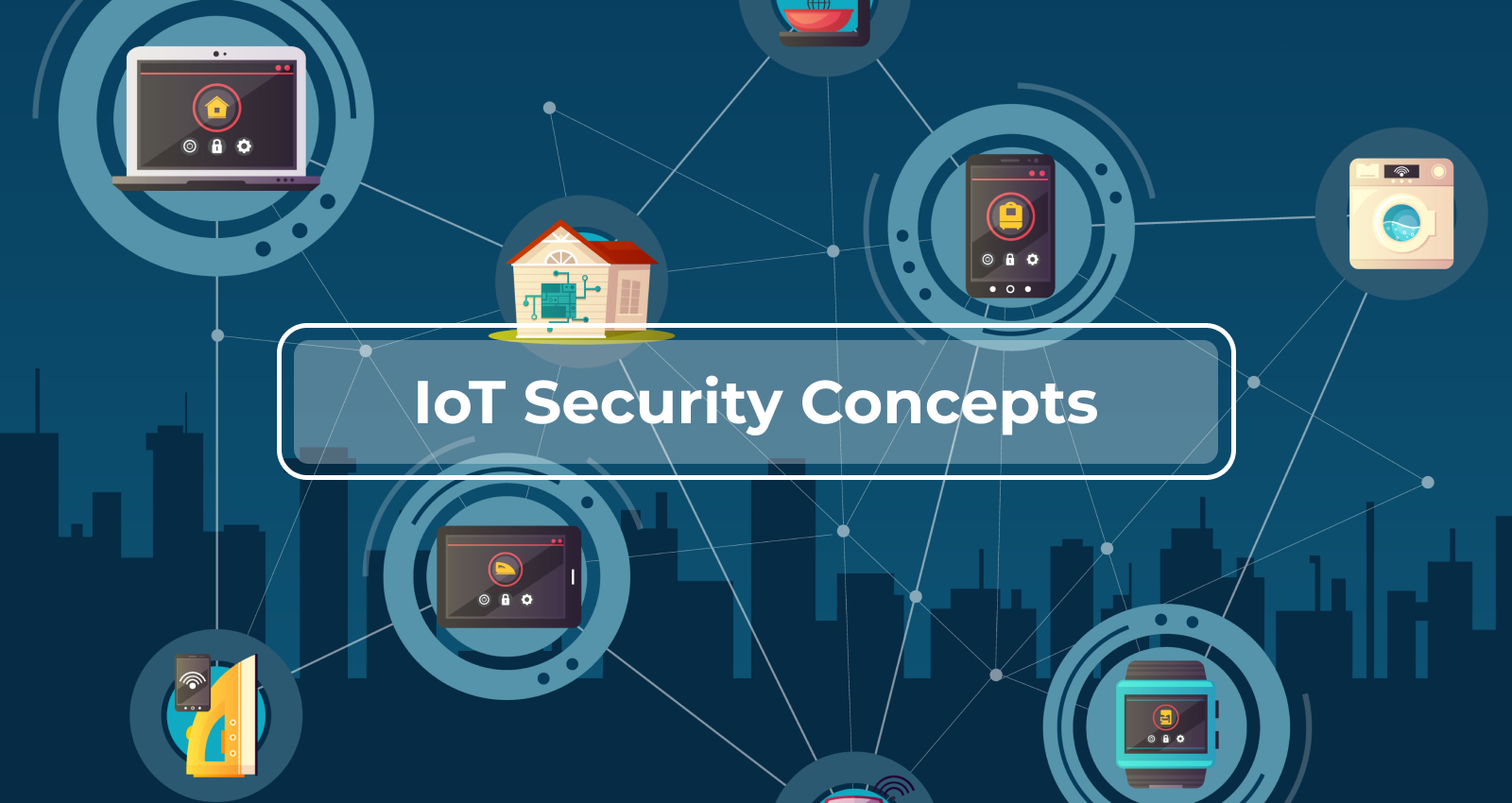IoT Device Security Concepts and Best Practices

Introduction
In today’s interconnected world, the Internet of Things (IoT) has revolutionized how we interact with technology, from smart homes to industrial automation. However, with this convenience comes the responsibility to ensure the security of IoT devices.
In this blog, we’ll explore why IoT device security is crucial, fundamental concepts, common threats, best practices, and parting words on securing your digital ecosystem.
Why IoT Device Security Can’t-Wait
IoT device security is not a luxury but a necessity in today’s digital age. With the rapid proliferation of interconnected devices, the urgency to prioritize their security cannot be overstated.
As our homes, businesses, and critical infrastructure become increasingly reliant on IoT technology, the potential consequences of a security breach are profound. From unauthorized access to sensitive data to disruption of essential services, the risks are too significant to ignore.
Therefore, investing in robust IoT device security measures is paramount to safeguarding against cyber threats. Delaying or overlooking security measures only increases the likelihood of exploitation by malicious actors. By recognizing the importance of securing IoT devices now, we can protect our digital ecosystems and ensure a safer and more resilient future.
Fundamental IoT Device Security Concepts:
Device Identity:
Every IoT device must possess a unique identifier, crucial for authenticating and authorizing its access to networks and services. Device identity management ensures that only trusted devices can interact within the IoT ecosystem, minimizing the risk of unauthorized access and malicious activities.
Implementing robust device identity mechanisms, such as cryptographic keys or digital certificates, enhances security by accurately verifying the identity of each device. By prioritizing device identity as a fundamental security concept, organizations can establish a strong foundation for protecting their IoT deployments against potential threats and unauthorized intrusions.
Data Encryption:
Encrypting data transmitted and stored by IoT devices is essential for safeguarding sensitive information from unauthorized access and interception. Encryption transforms data into an unreadable format using cryptographic algorithms, ensuring that even if intercepted, it remains indecipherable to unauthorized parties.
By implementing encryption techniques such as AES (Advanced Encryption Standard) or RSA (Rivest-Shamir-Adleman), organizations can protect the confidentiality and integrity of their data across the IoT ecosystem. Strong encryption practices mitigate the risk of data breaches and unauthorized disclosures, instilling confidence in the security and privacy of IoT deployments.
Secure Boot and Firmware Integrity:
Securing the boot process and firmware integrity of IoT devices is essential for preventing unauthorized access, tampering, and malicious modifications. Secure boot mechanisms verify the authenticity and integrity of the device firmware during the boot-up sequence, ensuring that only trusted and unaltered firmware is executed.
Additionally, firmware integrity checks detect and mitigate attempts to modify or compromise the device’s firmware, maintaining its integrity and trustworthiness. By incorporating secure boot and firmware integrity measures into IoT device designs, manufacturers can establish a robust defense against firmware-level attacks and unauthorized modifications, enhancing the overall security posture of IoT deployments.
Common IoT Device Security Threats
Malware and Botnets:
Malware and botnets pose significant threats to IoT device security, exploiting vulnerabilities to gain unauthorized access and control over devices. Malicious software, such as viruses, worms, and trojans, can infect IoT devices, compromising their functionality and integrity.
Once compromised, these devices can be enlisted into botnets, armies of compromised devices controlled by malicious actors to launch coordinated cyber-attacks or perform malicious activities.
Preventive measures, including regular software updates, antivirus software deployment, and network segmentation, are essential for mitigating the risks associated with malware and botnet infections, safeguarding IoT devices and the broader network infrastructure against compromise and exploitation.
Denial of Service (DoS) Attacks:
Denial of Service (DoS) attacks target IoT devices and networks by overwhelming them with excessive traffic or requests, disrupting their normal operation and rendering them inaccessible to legitimate users.
These attacks can be launched through various means, including flooding devices with network traffic, exploiting protocol vulnerabilities, or exploiting resource depletion vulnerabilities. The consequences of successful DoS attacks can be severe, resulting in service downtime, financial losses, and reputational damage.
Implementing robust network infrastructure, deploying intrusion detection and prevention systems, and employing traffic filtering mechanisms are crucial for mitigating the impact of DoS attacks and ensuring the availability and reliability of IoT services.
Physical Attacks:
Physical attacks on IoT devices involve unauthorized access, tampering, or theft of physical hardware components, posing significant risks to device security and integrity. Attackers may exploit physical vulnerabilities, such as weak enclosure designs or lack of tamper-resistant measures, to gain access to device internals or extract sensitive information.
Physical attacks can also involve tampering with device firmware or hardware components to bypass security mechanisms or gain unauthorized control over the device. Implementing physical security measures, such as tamper-evident seals, secure enclosures, and access control mechanisms, is essential for protecting IoT devices against physical attacks and maintaining their confidentiality, integrity, and availability in diverse operating environments.
IoT Device Security Best Practices
Strong Password Policies:
Enforcing strong password policies is paramount for IoT device security. Encourage users to create complex, unique passwords and avoid default or easily guessable credentials. Implement measures like password length requirements, character diversity, and regular password expiration to enhance resilience against brute-force attacks.
Additionally, consider multifactor authentication (MFA) to add an extra layer of security. By prioritizing strong password practices, organizations can significantly reduce the risk of unauthorized access and data breaches, bolstering the overall security posture of IoT deployments
Network Segmentation:
Network segmentation involves dividing the network into smaller, isolated segments to contain security breaches and limit unauthorized access to critical resources. By segmenting IoT devices into separate network zones based on their function, location, or sensitivity, organizations can mitigate the impact of potential security incidents and prevent lateral movement by attackers.
Implementing firewalls, access control lists (ACLs), and VLANs (Virtual Local Area Networks) facilitates granular control over network traffic and enhances security monitoring and enforcement capabilities.
Network segmentation is a fundamental best practice for securing IoT deployments and safeguarding against unauthorized access and lateral movement by threat actors
Regular Security Audits and Testing:
Regular security audits and testing are essential for identifying vulnerabilities, assessing the effectiveness of security controls, and ensuring compliance with security standards and regulations.
Conduct periodic vulnerability assessments, penetration tests, and security audits to proactively identify and remediate security gaps before they can be exploited by attackers. Utilize automated scanning tools, manual testing methodologies, and threat modeling techniques to comprehensively evaluate the security posture of IoT devices and associated infrastructure.
By prioritizing continuous security testing and auditing practices, organizations can detect and mitigate security vulnerabilities proactively, enhancing the resilience and robustness of their IoT deployments.
IoT Device Security Concepts: Final Words
In concluding our exploration of IoT device security concepts, it’s imperative to emphasize the ongoing evolution of threats and the need for a proactive, multi-layered approach to security. With the rapid proliferation of IoT devices, security must remain a top priority for manufacturers, developers, and end-users alike.
By staying vigilant, implementing robust security measures, and fostering collaboration across the ecosystem, we can effectively mitigate risks and ensure the safety and integrity of IoT deployments
Here are five top-rated apps to enhance IoT device security:
- Bitdefender IoT Security: Protects your IoT devices from cyber threats with real-time scanning and vulnerability assessment, ensuring a secure connected environment.
- Norton Core Secure WiFi Router: Provides advanced security features like device quarantine and parental controls to safeguard IoT devices and home networks from cyber threats.
- Fing – Network Scanner: Helps identify all devices connected to your network, allowing you to monitor IoT device activity and detect any unauthorized access or suspicious behavior.
- Cujo AI Smart Internet Security Firewall: Offers AI-driven threat detection and behavioral analysis to safeguard IoT devices against cyber-attacks and intrusions.
- Avast SecureLine VPN: Encrypts internet traffic from IoT devices, ensuring privacy and security, especially when accessing sensitive data or using public Wi-Fi networks.
Conclusion
In the ever-expanding landscape of IoT devices, security must remain a top priority. By understanding fundamental concepts, recognizing common threats, and implementing best practices, we can fortify our digital infrastructure against malicious actors. Let’s embrace the potential of IoT technology while safeguarding our privacy and security for a brighter, more connected future.
Are you looking for any IT Services such as Software Testing, Web design and Development, Professional/Staff Augmentation Services, Cloud Computing, Mobile App Development, Digital Marketing Services and more? Connect Stridefuture Technology, which helps to meet your requirements.
{StrideFuture Technology, a full-service company specializing in Software Solutions and Consultancy services. We specialize in Personal, Business, IT Services, Software Testing, Web design and Development, Mobile App Development, Digital Marketing Services, and much more you can dream Virtually with us! Reach out for more service at StrideFuture Technology.}









